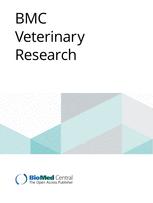Ver ítem
- xmlui.general.dspace_homeCentros e Institutos de InvestigaciónCICVyA. Centro de Investigación en Ciencias Veterinarias y AgronómicasInstituto de VirologíaArtículos científicosxmlui.ArtifactBrowser.ItemViewer.trail
- Inicio
- Centros e Institutos de Investigación
- CICVyA. Centro de Investigación en Ciencias Veterinarias y Agronómicas
- Instituto de Virología
- Artículos científicos
- Ver ítem
Multiplex PCR followed by restriction length polymorphism analysis for the subtyping of bovine herpesvirus 5 isolates
Resumen
Background: Several types and subtypes of bovine herpesviruses 1 and 5 (BoHV-1 and BoHV-5) have been associated to different clinical conditions of cattle, making type/subtype differentiation essential to understand the pathogenesis and epidemiology of BoHV infections. BoHV-5 subtyping is currently carried out by BstEII restriction enzyme analysis (REA) of the complete virus genome. This method allowed the description of three subtypes, one of which is
[ver mas...]
Background: Several types and subtypes of bovine herpesviruses 1 and 5 (BoHV-1 and BoHV-5) have been associated to different clinical conditions of cattle, making type/subtype differentiation essential to understand the pathogenesis and epidemiology of BoHV infections. BoHV-5 subtyping is currently carried out by BstEII restriction enzyme analysis (REA) of the complete virus genome. This method allowed the description of three subtypes, one of which is the most widespread while the remaining two have so far only been found in South America. The present work describes a multiplex PCR followed by REA for BoHV-5 subtyping.
Results: The method consists in the simultaneous amplification of glycoprotein B and UL54 gene fragments of 534 and 669 base pairs (bp), respectively, BstEII digestion of amplicons, separation of products in 1% agarose gels, and analysis of fragment length polymorphims. The multiplex PCR detected up to 227 BoHV-5 genome copies and 9.2 × 105 BoHV-5 genome copies when DNA was extracted from purified virus or infected tissue homogenates, respectively. The applicability of multiplex PCR-REA was demonstrated on 3 BoHV-5 reference strains. In addition, subtyping of two new isolates and seventeen previously reported ones (17 BHV-5a and 2 BHV-5b) by this method gave coincident results with those obtained with the classic BstEII REA assay.
Conclusions: Multiplex PCR-REA provides a new tool for the fast and simple diagnosis and subtyping of BoHV-5.
[Cerrar]

Autor
Maidana, Silvina Soledad;
Morano, Cintia Débora;
Cianfrini, Daniela;
Campos, Fabrício Souza;
Roehe, Paulo Michel;
Siedler, Bianca;
De Stefano, Gabriel Alejandro;
Mauroy, Axel;
Thiry, Etienne;
Romera, Sonia Alejandra;
Fuente
BMC Veterinary Research 39 : 111 (2013)
Fecha
2013-06
Editorial
BMC
ISSN
1746-6148
Formato
pdf
Tipo de documento
artículo
Palabras Claves
Derechos de acceso
Abierto
 Excepto donde se diga explicitamente, este item se publica bajo la siguiente descripción: Creative Commons Attribution-NonCommercial-ShareAlike 2.5 Unported (CC BY-NC-SA 2.5)
Excepto donde se diga explicitamente, este item se publica bajo la siguiente descripción: Creative Commons Attribution-NonCommercial-ShareAlike 2.5 Unported (CC BY-NC-SA 2.5)


